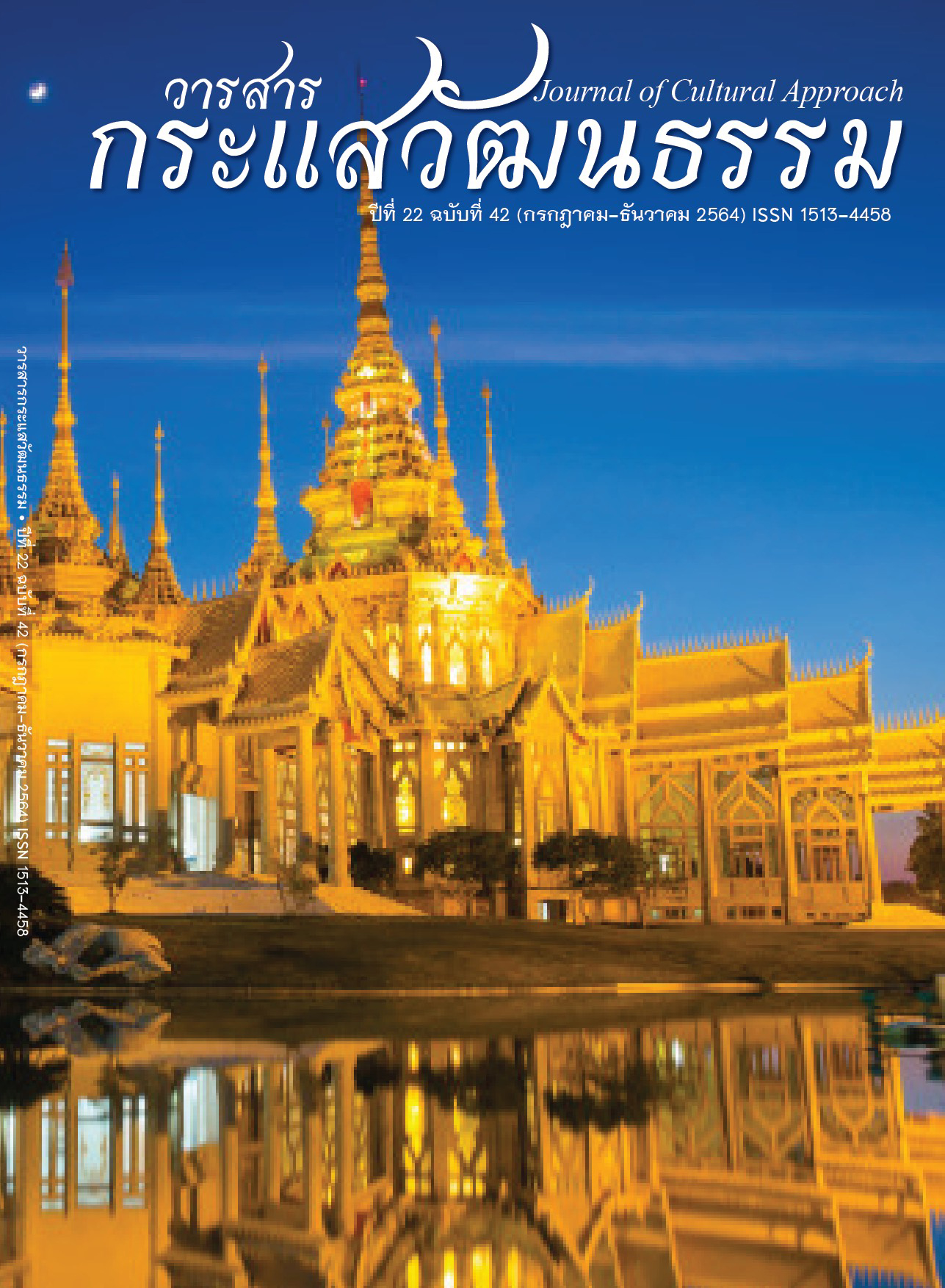การสื่อสารดิจิทัลกับการธำรงรักษาวัฒนธรรมหมอลำเรื่องต่อกลอน กรณีศึกษาคณะประถมบันเทิงศิลป์
Main Article Content
บทคัดย่อ
หมอลำเรื่องต่อกลอนเป็นวัฒนธรรมพื้นบ้านของภาคตะวันออกเฉียงเหนือที่ควรจะอนุรักษ์เพื่อให้ธำรงอยู่ท่ามกลางกระแสการเปลี่ยนแปลงของสื่อและเทคโนโลยี การวิจัยครั้งนี้จึงมีวัตถุประสงค์เพื่อวิเคราะห์พฤติกรรมใช้สื่อดิจิทัลของแฟนคลับหมอลำเรื่องต่อกลอน คณะประถมบันเทิงศิลป์ เป็นการวิจัยเชิงปริมาณ โดยกลุ่มตัวอย่างได้แก่ แฟนคลับที่ใช้เฟซบุ๊กแฟนเพจคณะประถมบันเทิงศิลป์ จำนวน 400 คน กำหนดขนาดกลุ่มตัวอย่างโดยใช้ตารางเทียบหากลุ่มตัวอย่างของ Yamane (1967) ใช้วิธีการประมาณ
ค่าสัดส่วนของกลุ่มตัวอย่าง เครื่องมือในการเก็บรวมรวมข้อมูลเป็นแบบสอบถามมาตราส่วนประมาณ
ค่า 5 ระดับ ซึ่งมีค่าความเชื่อมั่นทั้งฉบับเท่ากับ 0.98 สถิติที่ใช้ในการวิเคราะห์ข้อมูล ได้แก่ ค่าความถี่
ค่าร้อยละ ค่าเฉลี่ย ส่วนเบี่ยงเบนมาตรฐาน การทดสอบค่าที การทดสอบค่าเอฟ และการวิเคราะห์สหสัมพันธ์
ผลการวิจัยพบว่า แฟนคลับคณะประถมบันเทิงศิลป์ส่วนใหญ่พบว่าเป็นเพศชาย คิดเป็นร้อยละ 75.5 มีอายุระหว่าง 31-40 ปี คิดเป็นร้อยละ 37.8 สถานภาพโสด คิดเป็นร้อยละ 47.3 ระดับการศึกษาปริญญาตรี คิดเป็นร้อยละ 56.5 มีอาชีพพนักงานบริษัทเอกชน คิดเป็นร้อยละ 41.8 และรายได้เฉลี่ยต่อคนต่อเดือน 10,001-20,000 บาท คิดเป็นร้อยละ 37.3 ผลการทดสอบสมมติฐานพบว่า แฟนคลับที่มีเพศต่างกันมีพฤติกรรมการใช้เฟซบุ๊กแฟนเพจคณะประถมบันเทิงศิลป์ไม่แตกต่างกัน และแฟนคลับที่มีการเปิดรับสื่อ เฟซบุ๊กแฟนเพจคณะประถมบันเทิงศิลป์เหมือนกันมีพฤติกรรมการใช้เฟซบุ๊กแฟนเพจคณะประถมบันเทิงศิลป์ไม่เหมือนกันอย่างมีนัยสำคัญทางสถิติที่ระดับ 0.05
Article Details
Proposed Creative Commons Copyright Notices
1. Proposed Policy for Journals That Offer Open Access
Authors who publish with this journal agree to the following terms:
- Authors retain copyright and grant the journal right of first publication with the work simultaneously licensed under a Creative Commons Attribution License that allows others to share the work with an acknowledgement of the work's authorship and initial publication in this journal.
- Authors are able to enter into separate, additional contractual arrangements for the non-exclusive distribution of the journal's published version of the work (e.g., post it to an institutional repository or publish it in a book), with an acknowledgement of its initial publication in this journal.
- Authors are permitted and encouraged to post their work online (e.g., in institutional repositories or on their website) prior to and during the submission process, as it can lead to productive exchanges, as well as earlier and greater citation of published work (See The Effect of Open Access).
Proposed Policy for Journals That Offer Delayed Open Access
Authors who publish with this journal agree to the following terms:
- Authors retain copyright and grant the journal right of first publication, with the work [SPECIFY PERIOD OF TIME] after publication simultaneously licensed under a Creative Commons Attribution License that allows others to share the work with an acknowledgement of the work's authorship and initial publication in this journal.
- Authors are able to enter into separate, additional contractual arrangements for the non-exclusive distribution of the journal's published version of the work (e.g., post it to an institutional repository or publish it in a book), with an acknowledgement of its initial publication in this journal.
- Authors are permitted and encouraged to post their work online (e.g., in institutional repositories or on their website) prior to and during the submission process, as it can lead to productive exchanges, as well as earlier and greater citation of published work (See The Effect of Open Access).
เอกสารอ้างอิง
Best, J. W. (1997). Research in Education. Englewood Cliffs, New Jersey: Prentice–Hall.
Chairuek, P. (2002). A Study on Internet Using Behaviors of Under Graduated Students at King Mongkut’s University of Technology Thonburi. School of Industrial Education, King Mongkut’s University of Technology Thonburi.
Hunt, T. & Ruben, B. D. (1993). Mass Communication: Producers and Consumers. New York: HarperCollins College Publishers.
Kaewthep, K. (2009). Mass Communication: Educational Theories and Guidelines. Bangkok: Chulalongkorn University Press.
Khorpornprasert, B. (2004). The Behavior and Impacts of Using Facebook of University Students in Bangkok. Romphruek Journal, Krirk University, 32(2), 1-24.
Onnuam, W. (2012). The Communication Phenomenon in Digital Age. APHEIT Journal, 18(2), 212–220.
Prathombanterngsin Fanpage. (2019). Prathombanterngsin. Retrieved from http://www.facebook.com/groups/515882198498565.
Suksri, O. (2007). Communication on Website for Identity Construction and Sign of Foreign Football Fanclub A Case Study: Red Army Fan Club. Faculty of Arts, Graduate School, Dhurakij Pundit University.
Suwannachote, P. (2008). Communication, Parasocial Interaction and Pro-social Value Learning of Korean Star Singers’ Fanclub. Faculty of Communication Arts, Chulalongkorn University.
Tharaphot, T. & Dumrisuk, S. (2001). Human Behavior and Self Development. Bangkok: Thipayawisut.
Yamane, T. (1967). Statistics: An Introductory Analysis. New York: Harper and Row.


